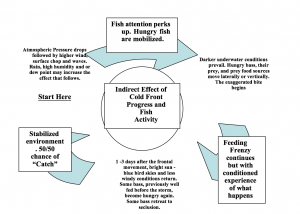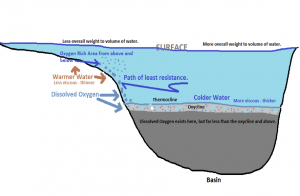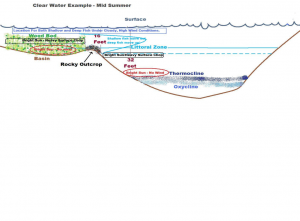Fishing Pattern: Understanding the Basics
A fishing pattern is a combination of water, weather, and environmental conditions such as light penetration, depth, cover, bottom structure, air and water temperature, water clarity, direction and speed of water currents, and Solunar Tables. These factors, along with the habits of predator fish and their prey, influence the success of catching fish at specific locations in a body of water. It’s important to note that different parts of the same lake can have entirely different patterns, and higher altitude lakes can have similar effects, shortening what is considered “normal” in lower elevation lakes.
bottom structure, air and water temperature, water clarity, direction and speed of water currents, and Solunar Tables. These factors, along with the habits of predator fish and their prey, influence the success of catching fish at specific locations in a body of water. It’s important to note that different parts of the same lake can have entirely different patterns, and higher altitude lakes can have similar effects, shortening what is considered “normal” in lower elevation lakes.
Angling Chef By: Richard Ziert
Patterns change! A pattern that works now might be useless tomorrow, and multiple successful patterns can exist simultaneously on any body of water, especially large reservoirs or lakes. Stable conditions can sustain a successful fishing pattern for a long time, while rapidly changing conditions can cause a successful pattern to disappear in minutes.
Recipe for Success:
Start a weather log 3-5 days before your outing. Include details such as wind, rain, warm or cold fronts, and their speed and direction. The location of your lake, whether North to South or East to West, and its elevation can have specific weather patterns. For instance, lakes in the northern half of the country typically experience weather from the West/Northwest, while those in the southern half usually see weather from the South/Southwest.
The direction of the weather can provide clues about which parts of your lake will be most productive. Factors such as water dynamics, species habits, lake basin makeup, and dissolved oxygen content can indicate the most promising areas to explore. Also, consider the seasonal angle of the sun and how long it will shine on various parts of the lake. Shallower waters and darker bottoms warm faster and hold heat longer into the day.
Debunking Cold Front Myths:
Cold fronts and their associated changes in atmospheric pressure are often blamed for exaggerated changes in fish activity. However, barometric pressure alone does not change quickly enough to have primary effects on fish behavior. It is just one ingredient in the overall process of fish location features. Factors such as air and water temperature, time of year/day, cloud cover, wind direction and speed, and humidity also affect fishing conditions.
Understanding Water Pressure and Temperature:
 Water pressure at 32 feet depth is equal to two atmospheres of pressure at the surface. Higher altitudes will alter this depth. For instance, the difference between normal strong high pressure (30.70 inches) and the powerful lows of hurricanes (28 inches) is about .09 atmospheres. A passing cold front causes only about .06 atmospheres of pressure change, affecting just over a foot and a half of water from the surface downward.
Water pressure at 32 feet depth is equal to two atmospheres of pressure at the surface. Higher altitudes will alter this depth. For instance, the difference between normal strong high pressure (30.70 inches) and the powerful lows of hurricanes (28 inches) is about .09 atmospheres. A passing cold front causes only about .06 atmospheres of pressure change, affecting just over a foot and a half of water from the surface downward.
Colder water is denser and harder to move. During spring, lake water warms from the top down, with the nationwide average water column getting colder at approximately 2 degrees per foot of depth. Waves can also alter shallow water column pressure, sometimes offsetting atmospheric pressure changes.
Fish Behavior and Light Penetration:
Fish behavior is influenced by various factors, including light penetration. On sunny, clear days with little or no wind, bass are usually found on or near the bottom, within cover, or at a depth where light penetration is less. As clouds approach, many fish, including prey, rise in the water column or move to the edges of cover. Bass eyes use rods and cones much like humans, taking 15-20 minutes to adjust to changing light conditions. During darker conditions, predator fish can have a better advantage at capturing prey.
Fishing During Cold Fronts:
Just before a cold front, the sky is usually clear and bright, followed by changes in air pressure. The wind picks up, creating surface chop and waves, which make for an intermittent darker underwater environment. This signals fish to start a feeding frenzy. During the storm, the sky is dark with clouds, and the wind is stronger. Typically, the cloud cover and winds peter out over 1-3 days, returning to pre-storm conditions.
Water Clarity and Fish Location:
 Understanding water clarity can help determine where to fish. For example, when a white lure disappears at 15 feet or more, the water is “super clear”; at 10 feet, it’s “clear”; at 5-10 feet, it’s “slightly stained”; at 3-5 feet, it’s “stained”; and at 1 foot or less, it’s “muddy.” Fish behavior can vary based on water clarity and light penetration, with different strategies required for different conditions.
Understanding water clarity can help determine where to fish. For example, when a white lure disappears at 15 feet or more, the water is “super clear”; at 10 feet, it’s “clear”; at 5-10 feet, it’s “slightly stained”; at 3-5 feet, it’s “stained”; and at 1 foot or less, it’s “muddy.” Fish behavior can vary based on water clarity and light penetration, with different strategies required for different conditions.
Solunar Tables and Fishing:
The Solunar Theory suggests that animals and fish move according to the moon’s location. Solunar Tables help determine the best days and times for fishing based on the alignment of the sun and moon. Fish are more active during a 90-minute window surrounding the times when the moon is directly underfoot or overhead.
Final Notes:
Effective fishing requires understanding and adapting to various environmental factors, including water dynamics, weather conditions, and fish behavior. By keeping detailed logs, observing patterns, and applying knowledge of water pressure, temperature, and light penetration, anglers can increase their chances of success. Sharing insights and continuously learning from experience will further enhance fishing skills and results.
Acknowledgments:
Thanks to Ralph Manns, Matt Straw, and Thad Rains for their contributions and critiques of this work. Their insights and experiences have added valuable information to this guide.

